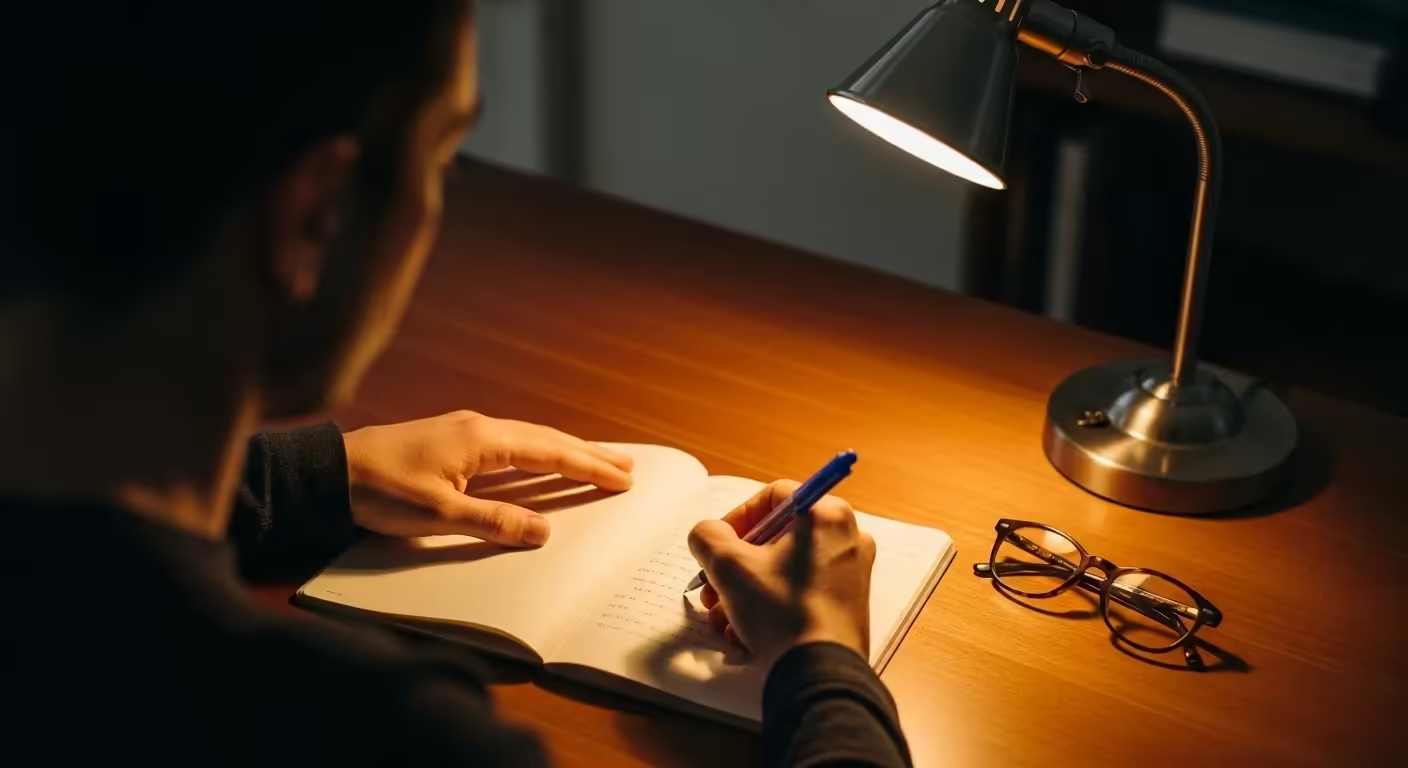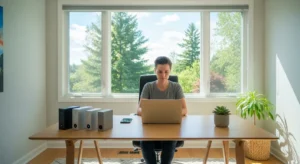
It’s 7:30 PM. Dinner is over, the evening is settling in, and you’ve finally sat down to relax. But your brain hasn’t. It’s still churning through the day’s to-do list, replaying a conversation with a colleague, and anticipating the chime of one last work email. You pick up your phone, intending to check the weather, but an hour later you find yourself scrolling through work chats and social media feeds, feeling more wired than when you started.
If this sounds familiar, you’re not alone. In our hyper-connected world, the line between work and life has become profoundly blurred. The digital tools that promise efficiency during the day often become sources of anxiety at night. The cost is high: diminished sleep quality, increased stress, and the feeling that you never truly get a break.
But what if the solution isn’t to abandon technology altogether? What if, instead of fighting our devices, we could teach them to respect our boundaries? This is the promise of a digital wind-down routine. It’s a series of small, intentional actions designed to signal to your brain that the workday is over, helping you transition peacefully into a state of rest and presence.
This guide is not about digital minimalism or extreme tech detoxes. It’s for busy professionals, parents, and anyone who feels tethered to their screen, seeking a balanced relationship with technology. We’ll explore the psychology behind why it’s so hard to switch off and provide practical, step-by-step strategies to help you create an after-work routine that reclaims your evenings and protects your well-being.
You don’t need to throw your phone in a drawer for five hours. You just need a plan. Let’s build one together.
📚 Table of Contents
- Why Your Brain Stays “On” After Work: The Science of Digital Distraction
- Building Your Digital Wind-Down Routine: Practical Phone Setups
- Master Your Focus Modes
- Triage Your Notifications Like a Pro
- Redesign Your Home Screen for Calm
- Use App Timers to Reclaim Your Time
- Creating a Supportive Environment for Your Mind
- Establish Screen-Free Zones
- Cultivating a Sleep-Friendly Evening
- The Power of “Closing Rituals” for Work
- Putting It All Together: Worked Examples
- Your 10-Minute Evening Digital Wind-Down Routine
- A Realistic Weekend “Digital Reset” (Without Going Offline)
- Troubleshooting Common Challenges
- When You “Relapse” and Check Work Email at 10 PM
- Handling the Fear of Missing Out (FOMO)
- Navigating Social and Professional Expectations
- Frequently Asked Questions About the Digital Wind-Down
- What about privacy concerns with focus modes and app timers?
- I work a night shift or have irregular hours. How can I adapt this routine?
- I have kids and need to be reachable for emergencies. How do I balance that with unplugging?
- My boss and company culture expect me to be available after hours. What can I do?
- Can a digital wind-down really improve my sleep?
- Your First Steps to Reclaiming Your Evenings
Why Your Brain Stays “On” After Work: The Science of Digital Distraction
To effectively create a boundary with our digital lives, we first need to understand why that boundary is so difficult to maintain. The challenge isn’t a lack of willpower; it’s a battle against sophisticated systems designed to capture and hold our attention. The pull of your phone after hours is rooted in basic brain chemistry.
At the heart of this is a concept you’ve likely heard of: the dopamine loop. Dopamine is a neurotransmitter your brain releases when it anticipates a reward. It’s a powerful motivator. When you see a notification badge on your email or Slack icon, your brain gets a tiny hit of dopamine in anticipation of what it might be—a praise-filled message from your boss, a solution to a problem, or just something new. When you open the app and see the message, the loop is completed, and the behavior is reinforced.
This cycle is not inherently bad; it’s what drives us to seek food, social connection, and achieve goals. However, modern apps have weaponized it. The “pull-to-refresh” gesture on a social media feed or the unpredictable timing of notifications creates what psychologists call a “variable reward schedule.” Because you don’t know when the next reward (a “like,” a new email, a funny video) is coming, you keep checking. This is the same mechanism that makes slot machines so addictive.
Compounding this is the “task-switching penalty.” Every time you shift your attention from a real-world activity, like talking with your partner, to a digital one, like reading a work email, your brain pays a price. It takes mental energy to disengage, process the new information, and then attempt to re-engage with the original task. According to research bodies like the American Psychological Association, even brief interruptions can significantly disrupt focus and increase stress. When you’re constantly checking your phone after work, you’re subjecting your brain to dozens of these micro-switches, preventing it from ever fully settling into a relaxed state.
Imagine this common scenario for an adult living in a busy city: You leave the office and immediately check your email on the train ride home. While cooking dinner, you respond to a Slack message on your phone. As you eat, your phone is on the table, buzzing with notifications. Before bed, you scroll through LinkedIn to “stay informed.” Your body may have left the office, but your brain has been tethered to work—and a stream of dopamine-fueled distractions—all evening. It never received a clear signal to power down. A digital wind-down routine is designed to provide exactly that signal.

Building Your Digital Wind-Down Routine: Practical Phone Setups
The most effective way to change your behavior is to change your environment. In the digital world, your phone’s interface is your environment. By consciously designing it for calm instead of chaos, you can remove temptation at its source and make unplugging the path of least resistance. Let’s walk through setting up your phone to support your after-work peace.
Master Your Focus Modes
Modern smartphones (both iOS and Android) have powerful “Focus” or “Do Not Disturb” (DND) modes that go far beyond just silencing calls. These are the cornerstone of a successful digital wind-down routine. The goal is to create distinct modes for different parts of your day.
Start by creating an “Evening” or “Personal Time” focus mode. You can set this to activate automatically at a specific time, like 6:30 PM, or when you arrive at your home location. Customize it to do the following:
Allowed People: Only allow calls and messages from your inner circle—your partner, children, parents, or close friends. This alleviates the anxiety of being totally unreachable in an emergency.
Allowed Apps: Be ruthless here. For your evening mode, you might only allow apps like Maps, a music or podcast player, your camera, and perhaps a messaging app you use strictly for family. Explicitly block work-related apps like Outlook, Slack, Teams, and even professional social networks like LinkedIn. The app icons may even disappear from your screen while the mode is active, removing the visual cue to check them.
By automating this transition, you eliminate the need for constant decision-making. Your phone simply transforms into a less demanding, more personal tool at the end of the workday.
Triage Your Notifications Like a Pro
Notifications are the single biggest disruptor of our attention. A successful wind-down requires a firm notification strategy. The key is to differentiate between the urgent and the merely interesting. A call from your child’s school is urgent. A “like” on your Instagram photo is not.
The practice of notification batching is a game-changer. Both iOS and Android allow you to schedule non-urgent notifications to be delivered in a single “summary” once or twice a day. Instead of a constant trickle of interruptions, you get a consolidated report at a time of your choosing (for example, at 7 PM). This lets you stay informed without being perpetually distracted.
Go through your phone’s notification settings app by app. For each one, ask: “Do I need to know this information the second it happens?” For 90% of your apps, the answer is no. Turn off banners and sounds for these apps and relegate them to your scheduled summary. This simple act can dramatically reduce the number of times your phone pulls you out of the present moment.
Redesign Your Home Screen for Calm
Your home screen is prime real estate. If it’s cluttered with distracting, dopamine-triggering apps, you’re setting yourself up for failure every time you unlock your phone. The goal is to turn it into a serene launchpad for intentional actions, not a minefield of distractions.
Try the “utility” approach. Move all your apps off the main home screen and into the App Library or App Drawer. Then, consciously add back only the tools you need for quick access—apps like the camera, notes, calendar, and maps. Place your most tempting apps (social media, news, shopping) in a folder on the very last page of your home screen, forcing you to swipe deliberately to access them.
An even more powerful method is to use your Focus Modes to create custom home screens. Your “Work” focus mode can show a screen with your productivity apps. When your “Evening” mode activates at 6:30 PM, your phone can automatically switch to a different home screen that shows only your wellness, hobby, or family-related apps. The work apps don’t just get silenced; they become invisible.
Use App Timers to Reclaim Your Time
For the apps that are most difficult to resist, app timers are your best friend. This feature, built into most smartphones, allows you to set a daily time limit for specific apps or categories of apps. When you reach your limit, the app icon is grayed out, and you receive a notification that your time is up.
While you can override the limit, that extra step forces a moment of mindfulness. It makes you ask, “Do I really need to spend more time on this right now?” Set a 30-minute daily limit on Instagram. Give yourself a 15-minute limit for checking news apps. Most importantly, set a strict limit—or even a zero-minute limit—on work apps after your designated “off” time. This creates a hard stop that reinforces your commitment to unplugging.

Creating a Supportive Environment for Your Mind
While rejiggering your phone’s settings is a critical first step, your physical environment plays an equally important role in your ability to mentally disconnect. A digital wind-down is most effective when it’s supported by real-world rituals and boundaries. The goal is to create spaces and routines that naturally discourage mindless scrolling and encourage restorative activities.
Establish Screen-Free Zones
The most powerful environmental change you can make is to designate certain areas of your home as screen-free zones. This isn’t about deprivation; it’s about protecting the sanctity of spaces meant for connection and rest.
The number one candidate for a screen-free zone is your bedroom. The bedroom should be a sanctuary for sleep and intimacy, not for work and scrolling. The presence of a phone on your nightstand is a constant temptation. More importantly, the light from screens can interfere with your sleep. Devices emit blue light, a type of light on the visible spectrum that is particularly effective at suppressing the production of melatonin, the hormone that regulates your sleep-wake cycle. According to experts at the Sleep Foundation, exposure to blue light in the evening can make it harder to fall asleep and reduce the quality of your rest. Invest in an old-fashioned alarm clock and charge your phone overnight in another room, like the kitchen or living room.
The dinner table is another excellent choice for a screen-free zone. When phones are present at meals, they create a state of “continuous partial attention.” Even if you’re not actively using your phone, its mere presence divides your focus and hinders deep conversation. Making the table a device-free space promotes mindfulness, improves digestion, and strengthens your connection with whomever you’re sharing a meal.
Cultivating a Sleep-Friendly Evening
Your digital wind-down should seamlessly transition into a sleep wind-down. The hour before bed is crucial for preparing your mind and body for restorative sleep. This is the time to replace stimulating screen-based activities with calming, analog ones.
Adopt the “60-Minute Rule”: Aim to put all screens away at least one hour before you intend to go to sleep. This gives your brain time to detox from the constant influx of information and allows your melatonin levels to rise naturally. Wondering what to do with that time? Here are some ideas:
- Read a physical book or use an e-reader with the backlight turned off.
- Listen to a calming podcast, an audiobook, or relaxing music on a smart speaker.
- Do some light stretching or yoga.
- Write in a journal, reflecting on your day or planning for tomorrow.
- Have a conversation with your partner or family.
- Prepare your clothes or lunch for the next day.
The specific activity matters less than the act of replacing screen time with something that calms your nervous system. This practice has been shown to improve sleep outcomes, a finding supported by research from institutions like the National Institutes of Health.
The Power of “Closing Rituals” for Work
A successful evening wind-down begins the moment your workday ends. If you just slam your laptop shut and walk away, your brain often carries the unresolved tasks and mental clutter with it. A “closing ritual” is a short, consistent routine that signals the definitive end of your professional day.
This ritual only needs to take five minutes. It might look something like this: review your calendar for the next day, write down your top three priorities on a sticky note, quickly organize your desk, and close all work-related tabs on your computer. As you shut down your machine, you might even say a simple phrase out loud, such as, “The workday is complete.” This may sound silly, but this small, physical act creates a powerful psychological boundary, making it easier for your brain to release work-related thoughts and transition into personal time.

Putting It All Together: Worked Examples
The concepts we’ve discussed can feel abstract. To make them tangible, let’s walk through two practical examples: a simple, 10-minute routine to end your workday, and a realistic approach to a weekend digital reset that doesn’t require you to go completely off the grid.
Your 10-Minute Evening Digital Wind-Down Routine
This is a short, powerful sequence to perform at the very end of your workday. It acts as a bridge, guiding you from a state of high-alert productivity to one of calm and presence. You can adapt it to fit your needs.
Minutes 0-2: The Physical Shutdown. Before you touch your phone, address your primary workspace. Close your laptop. Tidy any papers or notes on your desk. If you work from home, put your work equipment out of sight if possible. This physical act of “closing up shop” is a powerful psychological cue.
Minutes 2-4: The Final Triage. Now, pick up your phone. Open your primary work communication apps (email, Slack, etc.) one last time. Spend no more than two minutes scanning for anything genuinely urgent that cannot wait until morning. Do not get pulled into long conversations or non-critical tasks. The goal is peace of mind, not more work.
Minutes 4-5: Activate Your Boundary. Manually activate your “Evening” or “Personal” Focus Mode. Watch as the work-related apps and notifications disappear from your screen. This is a moment of conscious transition. You are telling your device—and yourself—that your time is now your own.
Minutes 5-7: Relocate and Recharge. Walk your phone to its designated overnight charging spot, which should be outside your bedroom. Plug it in and leave it there. By creating physical distance, you dramatically reduce the likelihood of mindless evening scrolling.
Minutes 7-10: The Analog Re-entry. Spend the final three minutes doing something completely non-digital. Make a cup of tea. Look out the window and notice the sky. Do a few simple stretches. Pet your dog. This final step helps ground you in your physical environment and solidifies the mental shift away from the digital world.
A Realistic Weekend “Digital Reset” (Without Going Offline)
The idea of a full weekend digital detox can be daunting and impractical for many. A more sustainable approach is a “digital reset,” which focuses on intentionality rather than complete abstinence. Here’s a sample plan.
The Goal: To use technology as a tool for connection and utility, not as a default source of entertainment or a vehicle for work creep.
Saturday Morning: Work-Free and Purposeful. The most important rule for the weekend: all work notifications remain off. This is non-negotiable. Use your phone for specific, helpful tasks. Use it to navigate to the farmer’s market, play a podcast while you do chores, or coordinate plans with friends via text. The key is that you are initiating the interaction with a clear purpose, rather than reactively responding to an endless stream of alerts.
Saturday Afternoon: The “Scroll Session.” Quitting social media cold turkey often backfires. Instead, schedule a “scroll session.” Set a timer for 30 minutes in the afternoon. During this time, you can guilt-free catch up on all your feeds. When the timer goes off, close the apps and put your phone down. This approach satisfies the urge to connect and be informed without letting it consume your entire day.
Sunday Evening: The “Pre-Game” to Reduce Anxiety. For many, Sunday evening is filled with “scaries”—anxiety about the upcoming work week. A brief, controlled check-in can actually alleviate this. Around 7 PM, give yourself 15 minutes to look at your work calendar and scan your inbox. The goal is simply to get a mental map of the week ahead. Do not reply to anything. This proactive check-in prevents Monday morning surprises and allows your brain to feel prepared, paradoxically helping you relax more deeply for the rest of the evening.

Troubleshooting Common Challenges
Implementing a new routine is rarely a smooth, linear process. You will have moments of relapse, face external pressures, and question whether it’s worth the effort. Anticipating these challenges is the key to overcoming them. Let’s address some of the most common hurdles.
When You “Relapse” and Check Work Email at 10 PM
It will happen. You’ll be bored, anxious, or just fall into an old habit, and you’ll find yourself scrolling through your inbox long after you intended to stop. The most important thing is not to see this as a failure. It’s a data point.
Instead of feeling guilty, get curious. Ask yourself: “What triggered this?” Were you feeling anxious about a specific project? Were you trying to avoid a difficult conversation at home? Were you simply bored? Understanding the underlying reason can help you find a better, non-digital solution for the next time that feeling arises. If it was anxiety, perhaps a better outlet would be five minutes of journaling. If it was boredom, maybe keeping a book on the coffee table would provide an easier alternative.
Don’t let a single slip-up derail your entire effort. Acknowledge it, learn from it, and gently guide yourself back to your routine. The goal is progress, not perfection.
Handling the Fear of Missing Out (FOMO)
A major barrier to unplugging is the fear of missing something important—a critical work update, an urgent request, or a social opportunity. This anxiety is real, but it’s often overblown.
First, reframe your perspective from FOMO to JOMO—the Joy of Missing Out. Celebrate the joy of being present for your child’s bedtime story, the pleasure of an uninterrupted dinner conversation, or the simple peace of a quiet mind. What you gain in real-world presence is almost always more valuable than what you might be missing online.
Second, establish a clear “emergency channel.” Let your boss and key colleagues know that if there is a true, building-is-on-fire emergency after hours, they should call you. This reassures you (and them) that you are reachable for genuine crises, freeing you from the obligation to monitor email and Slack for problems that can wait until morning.
Navigating Social and Professional Expectations
Sometimes the pressure to be constantly available comes from others. Your boss might send emails at 9 PM, or your friends might plan exclusively through a hyperactive group chat. Setting boundaries in this context requires clear, consistent communication.
You don’t need to make a grand proclamation. Instead, lead by example. When you receive a late-night work email, resist the urge to reply immediately. Address it first thing the next morning. If your boss asks, you can say, “I saw your email last night and have made it my first priority this morning.” This shows you’re responsible while subtly reinforcing your working hours.
For social situations, you can be more direct but still gentle. In a busy group chat, you might say, “Hey everyone, I’m trying to be on my phone less in the evenings, so if you need me urgently, just give me a call!” Over time, people will learn your communication patterns. Consistency is what turns your personal boundary into a respected, shared understanding.

Frequently Asked Questions About the Digital Wind-Down
What about privacy concerns with focus modes and app timers?
This is a valid question. The good news is that core features like Apple’s Focus modes and Google’s Digital Wellbeing tools are designed to be on-device functionalities. The data about your app usage and notification settings is processed locally on your phone to provide you with personal insights and controls. It is generally not sent to the company’s servers or used for advertising. These features are intended to be personal wellness tools, putting you in control of your data and your digital experience.
I work a night shift or have irregular hours. How can I adapt this routine?
The principles of a digital wind-down are universal and not tied to a traditional 9-to-5 schedule. The key is to create a clear buffer zone between “work time” and “personal time,” whenever those periods occur for you. Instead of setting your “Evening” mode to activate at 6 PM, you might set your “Post-Shift” mode to begin at 8 AM when you get home. Your “closing ritual” might happen at dawn instead of dusk. The goal remains the same: to create a consistent routine that signals to your brain that it’s time to switch off from work-related demands and enter a period of rest, regardless of the time on the clock.
I have kids and need to be reachable for emergencies. How do I balance that with unplugging?
This is precisely where the power of customizing your phone’s settings comes in. A digital wind-down is not about being unreachable; it’s about being selectively reachable. When you set up your “Personal Time” focus mode, you can designate specific contacts as “favorites” or create a list of allowed callers. This means that while a notification from your boss’s email will be silenced, a call or text from your child’s school, your partner, or the babysitter will come through immediately. You can rest easy knowing that the truly important people can always get ahold of you, while the digital noise is filtered out.
My boss and company culture expect me to be available after hours. What can I do?
This is a challenging situation that requires a strategic, gradual approach. Going from 24/7 availability to complete radio silence overnight can be jarring. Start by creating small, incremental boundaries. For instance, begin by not answering emails after 10 PM. Once that becomes comfortable, move it to 9 PM. The key is to pair this boundary with proactive communication. For example, at the end of the day, you can send a brief message to your team: “Signing off for the evening. I’ll be back online at 8 AM and will address the project proposal then.” This demonstrates responsibility and manages expectations, showing that you are not ignoring work, but rather, managing your time effectively.
Can a digital wind-down really improve my sleep?
Yes, absolutely. The connection between pre-sleep habits and sleep quality is well-documented. A digital wind-down routine helps on two primary fronts. First, as we’ve discussed, it reduces your exposure to blue light from screens, which can interfere with your body’s natural production of the sleep hormone melatonin. Second, it calms your mind. Engaging with stimulating, emotionally charged content—like work emails or contentious social media debates—before bed can put your brain into a state of high alert, making it difficult to fall asleep. By replacing this with calming, analog activities, you’re helping your nervous system shift from a “fight or flight” mode to a “rest and digest” mode, creating the ideal mental conditions for deep, restorative sleep. Leading health organizations like the Sleep Foundation consistently recommend a screen-free wind-down period as a core component of good sleep hygiene.
Disclaimer: This article is for informational purposes only and does not constitute medical or psychological advice. Please consult with a qualified professional for any health concerns.

Your First Steps to Reclaiming Your Evenings
Creating a healthier relationship with technology is not about a single, massive overhaul. It’s about a series of small, sustainable changes that compound over time. The goal isn’t to be perfect overnight; it’s to be intentional, starting now. You don’t need to implement everything in this guide at once. Instead, pick one or two small actions you can take this week to begin building your digital wind-down routine.
Here are a few simple, high-impact changes to get you started:
1. Relocate Your Charger Tonight. Before you go to bed, find a new spot for your phone charger in a room that is not your bedroom. Make this its permanent home. This single action creates physical distance and immediately makes your bedroom a more restful sanctuary.
2. Set Up One Focus Mode. Take 15 minutes to create your first “Personal Time” or “Evening” focus mode. Set it to automatically turn on at 7:30 PM. For now, just have it silence notifications from your top three most distracting apps. You can refine it later.
3. Choose One Screen-Free Meal. This week, commit to having one dinner—just one—where all phones are off the table and out of sight. Pay attention to your food, your thoughts, and the people you are with. Notice how it feels.
4. Implement a 5-Minute “Closing Ritual.” At the end of your next workday, before you close your laptop, take just five minutes to review tomorrow’s calendar and jot down your top priority. Tidy your desk. Then, consciously say to yourself, “I am done for the day.”
These are not drastic measures. They are small steps toward reclaiming your time, your focus, and your peace of mind. By ending your day with intention, you give yourself the gift of a truly restorative evening, allowing you to show up tomorrow as a more present, focused, and balanced version of yourself.






